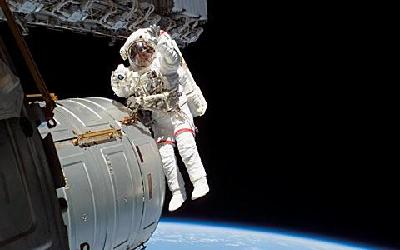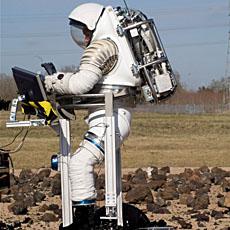
STEVE EMBER: I'm Steve Ember.
SHIRLEY GRIFFITH: And I'm Shirley Griffith with the VOA Special English program EXPLORATIONS. Today we tell about the special clothes astronauts wear that protect them while they work in space.
(MUSIC)
STEVE EMBER: Many questions had to be answered over 60 years ago when officials first began to think about placing a human being in space. One of the most important was how to design the special clothing needed to protect a person from the dangers of the space environment.
A person cannot work in the extremes of space without many different kinds of protection. The cold of space will freeze skin in a short time. The fierce heat of the sun can cause severe burns. The lack of atmosphere can cause gases and fluids in the body to expand and even burst.
And, with no oxygen to breathe, a human being will die in only a few moments. Any of these extreme conditions would mean a quick death for someone who did not wear special protective clothing. Ultraviolet radiation from the sun is another environmental risk in space. So is damage from small pieces of rock and objects like meteoroids.
SHIRLEY GRIFFITH: When humans explore and do useful work in space, they must take their natural environment with them. The American space agency, NASA, provides astronauts with a number of things that work together to create a protective environment. An astronaut who does work outside the space shuttle usually is wearing more than 17 pieces of protective equipment.
STEVE EMBER: The atmosphere is about 20% oxygen and 80% nitrogen from Earth's surface to where space begins at 120 kilometers up. Yet up at about 5,400 meters the air pressure is only about half of what it is on the ground. At about 19,000 meters, the air is so thin and the amount of oxygen so small that a person needs a lot of special equipment to survive.
A well-known American flyer, Wiley Post, designed one of the first successful devices to protect a pilot at extreme heights. In 1933, he developed protective clothing that made it possible for him to fly very high. Today, aircraft are designed to prevent air pressure changes at extreme heights. But this was not yet possible in 1933.
SHIRLEY GRIFFITH: Wiley Post made this protective clothing with the help of the Phillips Petroleum Company and the B-F Goodrich Company. It appeared to be something a person would wear to stay underwater for long periods of time. A large device that looked like a can surrounded the pilot's head. A small window in the front permitted him to see.
Wiley Post's protective clothing was made of rubber. It could hold oxygen and provide the needed air pressure to protect his body from the lack of pressure at extreme heights. This protective suit was only used a few times, but it permitted Mr. Post to fly as high as 15,000 meters. That was higher than any person had ever flown. Mr. Post did not know it, but he had designed the first real spacesuit. His suit is now part of the collection of the Smithsonian Institution's Air and Space Museum in Washington, DC.
(MUSIC)
STEVE EMBER: Astronauts in NASA's Mercury Program flew the first American space flights in the early 1960s. Each set of protective clothing was specially made for each astronaut. The clothing was similar to that invented by Wiley Post. And, it presented some of the same problems.
When air pressure filled the early spacesuit, astronauts found it difficult to move their arms or legs. It was a little like trying to change the shape of a balloon. The pressure inside the suit provided protection, but made it difficult for the astronaut to move in a natural way.
Mercury astronauts usually wore the suit without air pressure inside. The Mercury spacecraft had the needed atmospheric pressure to keep the astronauts safe. The astronauts wore the suit as a safety device in case the spacecraft suddenly lost air pressure.
SHIRLEY GRIFFITH: Today, astronauts wear very different protective clothing. It lets them move, do useful tasks, and stay outside their spacecraft in comfort and safety for several hours.
For the next few minutes, imagine you are in the space shuttle about to go out to work in space.
STEVE EMBER: You will wear a spacesuit to work in the open cargo area of the Space Shuttle Discovery, which returned from its last flight last month. The spacesuit is called the shuttle extravehicular mobility unit or EMU. It was designed to last longer and to permit more movement than earlier spacesuits.
The EMU has a number of parts that an astronaut can link together by using only one hand. The different parts are in different sizes. This makes it possible for each astronaut to select the parts that fit correctly.
Wearing the whole EMU can add as much as 90 kilograms to your weight. Yet, the lack of gravity in space means you will not feel the added weight.
SHIRLEY GRIFFITH: You will be wearing equipment that will send medical information back to the NASA control center in Houston, Texas. Doctors will observe your medical condition while you work in space.
You also will wear a device that will collect urine, the body's liquid waste. You will be working outside the space shuttle for about five hours. This collection device can become very necessary.
STEVE EMBER: You will also wear something called the Liquid Cooling and Ventilation Garment. This piece of clothing is worn next to the skin. It helps keep the body cool by moving water through many small tubes that cover the device. The heat from the sun can reach 120 degrees Celsius in orbit. The material of the space suit helps protect against this heat. The liquid cooling device also works to keep your body from becoming too hot.
SHIRLEY GRIFFITH: You will also put on a container that holds water to drink. A small tube stays near your mouth so you can drink water during your stay in space. A special hat on your head is made of soft cloth. It also carries several communications devices including earphones and microphones. These communication devices will permit you to talk with other astronauts working outside the shuttle and with crew members inside the shuttle. You can also talk with the control center in Houston, Texas.
The lower part of the spacesuit is next. It is called the Lower Torso Assembly. It is like putting on a large pair of pants that have boots built in the bottom of the legs.
STEVE EMBER: Next comes the upper part of the spacesuit. It is made of a hard plastic-like material. To put it on, you must hold your arms over your head, and rise up into the upper part of the suit. The upper part of the suit also holds the Primary Life Support System.
The life support system supplies the oxygen needed for breathing and the air pressure necessary to protect your body. The upper part of the spacesuit also carries an emergency oxygen system in case the first system fails.
An important part of your spacesuit is the Control Module. It lets you observe and control your oxygen system. It is also the place you find the controls for your communications equipment. And, it tells you if you are having a problem with any of the spacesuit's devices.

SHIRLEY GRIFFITH: NASA scientists are also considering the kind of spacesuits that would be needed for exploration on the planet Mars. Because of the gravity on Mars, spacesuits may have to be designed to be lighter than suits used in orbit or on the moon. The equipment may also have to protect astronauts from dust carried in the winds on Mars. And, they must be easy to repair and keep clean during a longer flight to and from the red planet.
STEVE EMBER: All of the spacesuits that have returned from space belong to the Smithsonian Institution. Most of the suits are stored in a building about ten kilometers from Washington. They are kept in a room where air temperature and moisture levels are carefully controlled. The old spacesuits break easily. They were designed to protect the astronaut, and how they would last after a space operation was not a big consideration. Smithsonian experts must pay special attention to protect these suits because they help to tell the story of space exploration.
(MUSIC)
SHIRLEY GRIFFITH: This Special English program was written by Paul Thompson and Dana Demange, who was also the producer. I'm Shirley Griffith.
STEVE EMBER: And I'm Steve Ember. You can find our series online with transcripts, MP3s, podcasts and images at voaspecialenglish.com. You can also follow us on Facebook and Twitter at VOA Learning English. Join us again next week for another EXPLORATIONS program on the Voice of America.
ultraviolet: of or using electromagnetic waves that are just shorter than those of violet light in the spectrum and that cannot be seen 紫外線的;利用紫外線的
meteoroid: 流星體
China names 1st 'spacewalker' astronaut
Space shuttle program nears an end
Discovery preps for last space mission
(來源:VOA 編輯:崔旭燕)
